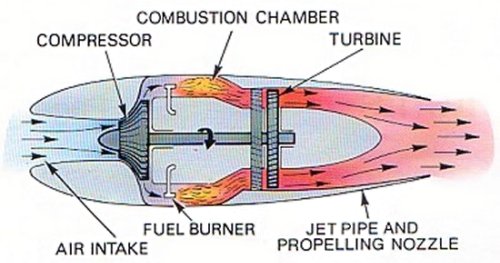jet engine

Bristol Siddeley Olympus BE.10 jet engine. A modified form of this engine powered the supersonic Concorde.

The principle of a jet engine illustrated by a balloon.

Hero's jet engine.

Basic components of a turbojet engine.
A jet is an engine that works by expelling a fluid jet backward so that the reaction to this exhaust propels the vehicle forward. Both the jet engine and the rocket engine are types of reaction engine, but whereas the rocket engine is self-contained and can work in a vacuum a jet engine can only function in the atmosphere.
Balloon jet and Newton's third law
The principle by which all jet engines (and rockets) work is the third of Newton's laws of motions, namely that for every action (force in one direction) there is an equal and opposite reaction (force in the opposite direction). A toy balloon demonstrates this idea very simply.
If an inflated balloon is untied and released it flies across a room. It may be thought that the balloon is moving because the stream of escaping air is pushing against the atmosphere, rather as a row boat is propelled by the oars pushing back against the water. But this is not so. The balloon would fly just as well in a vacuum where there was nothing for the escaping air to push against; in fact it would fly better. The explanation lies in the fact that the pressure of the air in an inflated balloon is equal and constant in all directions. It it were not, the balloon would be continually moving in the direction in which the pressure was greatest. When, however, the neck of the balloon is opened there is nothing for the compressed air to push against at that point and so is is able to escape. But the pressure on the opposite side of the balloon is still there and, since there is no longer any counter pressure to balance it, it can move the balloon. Thus the balloon flies across the room in the opposite direction from the escaping air.
Early history of the jet engine
The very first jet engine is said to have been constructed by Hero of Alexandria in the 1st century BC. The so-called aeolipile consisted of a metal sphere, with outlet pipes, mounted on a hollow axle. When steam was fed under pressure from a boiler through the hollow axle into the sphere it was able to escape through the outlet pipes. These were shaped in such a manner that the effect of the escaping steam was to cause the sphere to rotate.
Many centuries later, Isaac Newton constructed a model carriage which was jet propelled. This, too, relied upon steam escaping under pressure from the rear of the vehicle to provide a forward thrust.
The practical application of jet propulsion, however, is a fairly recent innovation. The first jet-propelled aircraft were the German Heinkel 178, which made its inaugural flight in 1939, and the British Gloster E.28/39 powered by Frank Whittle's turbojet, which first flew in 1941.
Parts of a jet engine
Air from the atmosphere is drawn into the front part of the engine and compressed by a compressor. This has numerous small blades and spins around rapidly. The compressed air flows into a combustion chamber, where fuel is injected, mixed with the air, and burned. In a typical jet engine, only about 1 kg of fuel is added for every 100 kg of air that enters the combustion chamber. Most of the hot exhaust comes from the surrounding air. Leaving the combustion chamber, the hot exhaust passes through a turbine. The flow of hot gas causes the turbine blades to spin around. A central shaft connects the turbine to the compressor, so that the compressor is turned by energy extracted from the hot exhaust. Plenty of energy is left over, however, to provide thrust to the jet engine by increasing the velocity through the exhaust nozzle. Because the exit velocity is greater than the free stream velocity, thrust is created.
Types of jet engine
The main types of jet engine are:


